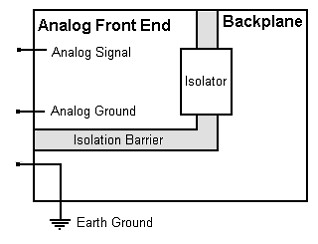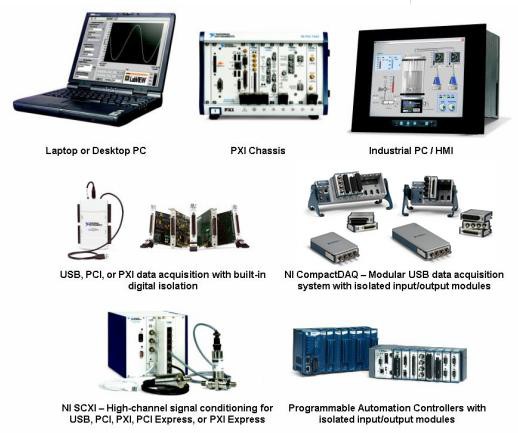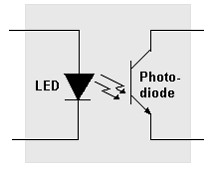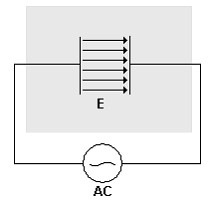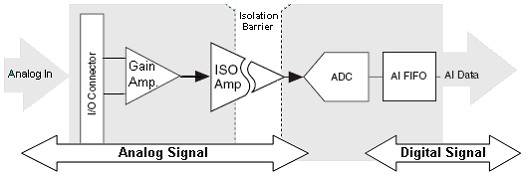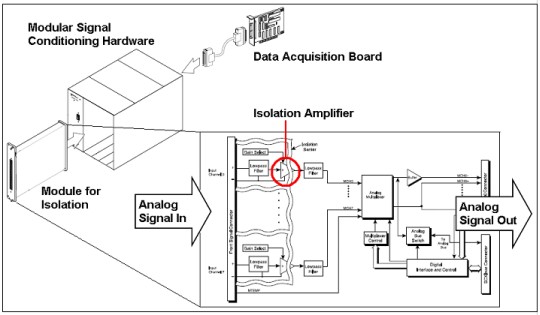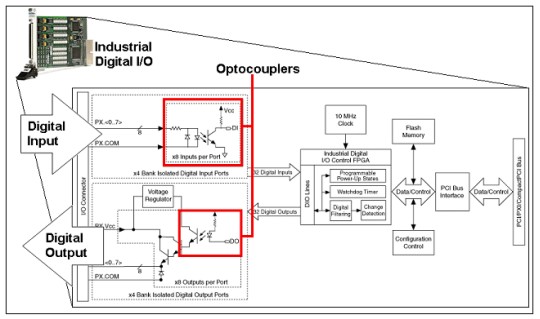Isolation Technologies for Reliable Industrial Measurements
Overview
Contents
- Understanding Isolation
- Need for Isolation
- Methods of Implementing Isolation
- Analog Isolation and Digital Isolation
- Summary
Understanding Isolation
Isolation electrically separates the sensor signals, which can be exposed to hazardous voltages1, from the measurement system’s low-voltage backplane. Isolation offers many benefits including:
- Protection for expensive equipment, the user, and data from transient voltages
- Improved noise immunity
- Ground loop removal
- Increased common-mode voltage rejection
Isolated measurement systems provide separate ground planes for the analog front end and the system backplane to separate the sensor measurements from the rest of the system. The ground connection of the isolated front end is a floating pin that can operate at a different potential than the earth ground. Figure 1 represents an analog voltage measurement device. Any common-mode voltage that exists between the sensor ground and the measurement system ground is rejected. This prevents ground loops from forming and removes any noise on the sensor lines.
Figure 1. Bank-Isolated Analog Input Circuitry
1Hazardous voltages are greater than 30 Vrms, 42.4 Vpk, or 60 VDC.
Need for Isolation
Consider isolation for measurement systems that involve any of the following:
- Close vicinity to hazardous voltages
- Industrial environments with possibility of transient voltages
- Environments with common-mode voltage or fluctuating ground potentials
- Electrically noisy environments such as those with industrial motors
- Transient-sensitive applications where it is imperative to prevent voltage spikes from being transmitted through the measurement system
Industrial measurement, process control, and automotive test are examples of applications where common-mode voltages, high voltage transients, and electrical noise are common. Measurement equipment with isolation can offer reliable measurements in these harsh environments. For medical equipment in direct contact with patients, isolation is useful in preventing power line transients from being transmitted through the equipment.
Based on your voltage and data rate requirements, you have several options for making isolated measurements. You can use plug-in boards for laptops, desktop PCs, industrial PCs, PXI, panel PCs, and CompactPCI with the option of built-in isolation or external signal conditioning. You also can make isolated measurements using programmable automation controllers (PACs) and measurement systems for USB, Ethernet and wireless.
Figure 2. Isolated Data Acquisition Systems
Methods of Implementing Isolation
Isolation requires signals to be transmitted across an isolation barrier without any direct electrical contact. Light-emitting diodes (LEDs), capacitors, and inductors are three commonly available components that allow electrical signal transmission without any direct contact. The principles on which these devices are based form the core of the three most common technologies for isolation – optical, capacitive, and inductive coupling.
Optical Isolation
LEDs produce light when a voltage is applied across them. Optical isolation uses an LED along with a photodetector device to transmit signals across an isolation barrier using light as the method of data translation. A photodetector receives the light transmitted by the LED and converts it back to the original signal.
Figure 3. Optical Isolation
Optical isolation is one of the most commonly used methods for isolation. One benefit of using optical isolation is its immunity to electrical and magnetic noise. Some of the disadvantages include transmission speed, which is restricted by the LED switching speed, high-power dissipation, and LED wear.
Capacitive Isolation
Capacitive isolation is based on an electric field that changes with the level of charge on a capacitor plate. This charge is detected across an isolation barrier and is proportional to the level of the measured signal.
Figure 4. Capacitive Isolation
One advantage of capacitive isolation is its immunity to magnetic noise. Compared to optical isolation, capacitive isolation can support faster data transmission rates because there are no LEDs that need to be switched. Because capacitive coupling involves the use of electric fields for data transmission, it can be susceptible to interference from external electric fields.
Inductive Coupling Isolation
In the early 1800s, Hans Oersted, a Danish physicist, discovered that current through a coil of wire produces a magnetic field. It was later discovered that current can be induced in a second coil by placing it in close vicinity of the changing magnetic field from the first coil. The voltage and current induced in the second coil depend on the rate of current change through the first. This principle is called mutual induction and forms the basis of inductive isolation.
Figure 5. Inductive Coupling
Inductive isolation uses a pair of coils separated by a layer of insulation. Insulation prevents any physical signal transmission. Signals can be transmitted by varying current flowing through one of the coils, which causes a similar current to be induced in the second coil across the insulation barrier. Inductive isolation can provide high-speed transmission similar to capacitive techniques. Because inductive coupling involves the use of magnetic fields for data transmission, it can be susceptible to interference from external magnetic fields.
Analog Isolation and Digital Isolation
Many of the commercial off-the-shelf (COTS) components available today incorporate one of the above technologies to provide isolation. For analog I/O channels, you can implement isolation either in the analog section of the device before the analog-to-digital converter (ADC) has digitized the signal (analog isolation) or after the ADC has digitized the signal (digital isolation). You need to design different circuitry around one of these techniques based on your isolation implementation location in the circuit. You can choose analog or digital isolation based on your data acquisition system performance, cost, and physical requirements. Figures 6a and 6b show the different stages of implementing isolation.
Figure 6a. Analog Isolation
Figure 6b. Digital Isolation
The following sections cover analog and digital isolation in more detail and explore the different techniques for implementing each.
Analog Isolation
The isolation amplifier is generally used to provide isolation in the analog front end of data acquisition devices. “ISO Amp” in Figure 6a represents an isolation amplifier, which, in most circuits, is one of the first components of the analog circuitry. The analog signal from a sensor is passed to the isolation amplifier, which provides isolation and passes the signal to the analog-to-digital conversion circuitry. Figure 7 represents the general layout of an isolation amplifier.
Figure 7. Isolation Amplifier
In an ideal isolation amplifier, the analog output signal is the same as the analog input signal. The section labeled “isolation” in Figure 7 uses one of the techniques discussed in the previous section (optical, capacitive, or inductive coupling) to pass the signal across the isolation barrier. The modulator circuit prepares the signal for the isolation circuitry. For optical methods, you need to digitize or translate this signal into varying light intensities. For capacitive and inductive methods, you need to translate the signal into varying electric or magnetic fields. The demodulator circuit then reads the isolation circuit output and converts it back into the original analog signal.
Because you perform analog isolation before the signal is digitized, it is the best method to apply when designing external signal conditioning for use with existing non-isolated data acquisition devices. In this case, the data acquisition device performs the analog-to-digital conversion and the external circuitry provides isolation. With the data acquisition device and external signal conditioning combination, measurement system vendors can develop general-purpose data acquisition devices and sensor-specific signal conditioning. Figure 8 shows analog isolation being implemented with flexible signal conditioning that uses isolation amplifiers. Another benefit to isolation in the analog front end is protection for the ADC and other analog circuitry from voltage spikes.
Figure 8. Use of Isolation Amplifiers in Flexible Signal Conditioning Hardware
There are several options available on the market for measurement products that use a general-purpose data acquisition device and external signal conditioning. For example, the NI M Series includes several non-isolated, general-purpose multifunction data acquisition devices that provide high-performance analog I/O and digital I/O. For applications that need isolation, you can use the M Series devices with external signal conditioning, such as the National Instruments SCXI or SCC modules. These signal conditioning platforms deliver the isolation and specialized signal conditioning you need for direct connection to industrial sensors such as load cells, strain gages, and pH sensors.
Digital Isolation
ADCs are one of the key components of any analog input data acquisition device. For best performance, the input signal to the ADC should be as close to the original analog signal as possible. Analog isolation can add errors such as gain, nonlinearity, and offset before the signal reaches the ADC. Placing the ADC closer to the signal source can lead to better performance. Analog isolation components are also costly and can suffer from long settling times. Despite better digital isolation performance, one of the reasons for using analog isolation in the past was to provide protection for the expensive ADCs. Because ADC prices have significantly declined, measurement equipment vendors are choosing to trade ADC protection for the better performance and lower cost offered by digital isolators.
Compared to isolation amplifiers, digital isolation components are lower in cost and offer higher data transfer speeds. Digital isolation techniques also give analog designers more flexibility to choose components and develop optimal analog front ends for measurement devices. Products with digital isolation use current- and voltage-limiting circuits to provide ADC protection. Digital isolation components follow the same fundamental principles of optical, capacitive, and inductive coupling that form the basis of analog isolation.
Leading digital isolation component vendors such as Avago Technologies (www.avagotech.com), Texas Instruments (www.ti.com), and Analog Devices (www.analog.com) have developed their isolation technologies around one of these basic principles. Avago Technologies offers digital isolators based on optical coupling, Texas Instruments bases its isolators on capacitive coupling, and Analog Devices isolators use inductive coupling.
Optocouplers
Optocouplers, digital isolators based on the optical coupling principles, are one of the oldest and most commonly used methods for digital isolation. They can withstand high voltages and offer high immunity to electrical and magnetic noise. Optocouplers are often used on industrial digital I/O products, such as the NI PXI-6514 isolated digital I/O module, shown in Figure 9, industrial motion controller.
Figure 9. Industrial Digital I/O Products Use Optocouplers
For high-speed analog measurements, optocouplers, however, suffer from speed, power dissipation, and LED wear limitations associated with optical coupling. Digital isolators based on capacitive and inductive coupling can alleviate many optocoupler limitations.
Capacitive Isolation
Texas Instruments offers digital isolation components based on capacitive coupling. These isolators provide high data transfer rates and high transient immunity. Compared to capacitive and optical isolation methods ,inductive isolation offers lower power consumption.
Inductive Isolation
iCoupler technology, introduced by Analog Devices in 2001 (analog.com/iCoupler), uses inductive coupling to offer digital isolation for high-speed and high-channel-count applications. iCoupler devices can provide 100 Mb/s data transfer rates with 2,500 V isolation withstand for a 16-bit analog measurement system that implies sampling rates in the megahertz range. Unlike optocouplers, iCoupler devices offer other benefits such as reduced power consumption, high operating temperature range up to 125 °C, and high transient immunity up to 25 kV/ms.
iCoupler technology is based on small, chip-scale transformers. An iCoupler has three main parts – a transmitter, transformers, and a receiver. The transmitter circuit uses edge trigger encoding and converts rising and falling edges on the digital lines to 1 ns pulses. These pulses are transmitted across the isolation barrier using the transformer and decoded on the other side by the receiver circuitry, shown in Figure 10. The small size of the transformers, about three-tenths of a millimeter, makes them practically impervious to external magnetic noise. iCoupler devices can also lower measurement hardware costs by integrating up to four isolated channels per integrated circuit (IC) and, compared to optocouplers, they require fewer external components.
Figure 10. Induction Coupling-Based iCoupler Technology from Analog Devices
Source: Analog Devices (analog.com/iCoupler)
Measurement hardware vendors are using iCoupler devices to offer high-performance data acquisition systems at lower costs. NI industrial data acquisition (DAQ) devices intended for high-speed measurements use iCoupler digital isolators. These devices provide 60 VDC continuous isolation and 1,400 Vrms/1,900 VDC channel-to-bus isolation withstand for 5 s on multiple analog and digital channels and support sampling rates up to 250 kS/s. NI C Series modules, which are used in CompactRIO or CompactDAQ systems, and some other high-speed NI USB, Ethernet, and wireless devices also use iCoupler technology.
Summary
Isolated data acquisition systems can provide reliable measurements for harsh industrial environments with hazardous voltages and transients. Your need for isolation is based on your measurement application and surrounding environments. Applications that require connectivity to different specialty sensors using a single, general-purpose data acquisition device can benefit from external signal conditioning with analog isolation; whereas, applications needing lower-cost, high-performance analog inputs benefit from measurement systems with digital isolation technologies.
NI provides a number of products that include various options for analog isolation, including channel-to-channel isolation and bank isolation at a variety of ranges. Visit the following pages in the NI catalog and use the Analog Input Isolation or Analog Output Isolation filters to find the option that best meets your needs.
- Multifunction I/O Device
- C Series Voltage Input Module
- C Series Voltage Output Module
- PXI Analog Input Module
- PXI Temperature Input Module
Additionally, NI also offers the PXIe-4322 PXI Analog Output Module, which offers channel-to-channel isolated voltage and current output.
